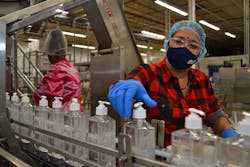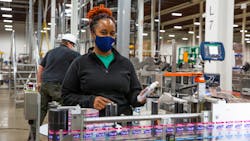GOJO Industries—manufacturer of Purell hand sanitizer, surface spray and soap products—was among the first companies whose products flew off the shelves and was in high demand at hospitals.
The third-generation family enterprise based in Akron, Ohio, has spent the past year trying to meet unprecedented demand. GOJO added additional manufacturing and distribution sites, including leasing 700,000 square feet to house inventory at the I-X Center in Cleveland, and shifted more lines to be open 24/7. The company added approximately 500 new team members for a global workforce of around 3,000 employees.
EHS Today Managing Editor Nicole Stempak spoke with Zach Wemple, chief human resources officer at GOJO, in late February to hear how the company has maintained operations while it’s been anything but business as usual.
EHS Today: What did you immediately start or stop as shelter-at-home orders went into effect?
Zach Wemple: A lot changed quickly at that time. We had a game plan of what we thought the year would look like, and that was largely gone as we got our arms around COVID. To start, we immediately formed a pandemic response team to lead all of our efforts. That cross-functional team had stakeholders from across the business, both to assess the situation and help us establish our action plan.
At a high level, they implemented a variety of safety protocols to keep our sites and our team members safe, made policy adjustments to support team members who might’ve been impacted by COVID, anticipated some of those scenarios going forward, and made a hard switch to remote work for everybody who was able to do so. That was a big shift as well, because we were a pretty physically present culture up until that point.
Can you share some examples of those safety protocols?
Wemple: That included all the best practices around social distancing, mask usage and hand hygiene. We made physical adjustments to our sites to make sure that we were supporting social distancing. We deployed ongoing, enhanced cleaning 24 hours a day at our sites across all high touch surfaces, so that we were regularly keeping those disinfected. We suspended guests and site tours so that only essential team members were at the site to keep them as safe as possible.
We made a number of policy adjustments, both for safety protocols and to help enforce those, but also to enhance our employee benefits around absences and special bonus programs to reward team members who worked through those acute stay-at-home periods to make sure that we were rising to meet them. We really tried to take a layered approach that looked at everything we could be doing across policies, programs, site decisions and so forth to make sure that when you stack it all together, then we have the most resilient, approach that we could have. [See more protocols in the “COVID-19 Safety Precautions” sidebar below.]
These safety measures were deployed quickly, but are there any that you expect to continue after the pandemic?
Wemple: I think we’re all going to be glad when masks and social distancing aren’t part of the daily routine, but there’s a lot that we actually learned through this that we’re going to take forward. At our manufacturing and distribution sites, we really learned the value of having pandemic responsive designs and pacing on our lines that we’ve incorporated into the new sites that we opened last year, so we’re adapting some of those learnings already. For our office population, we have an entire future of work initiative that is underway to re-imagine our approach to the office. I’m excited to see where that takes us, too.
Can you share more about this initiative?
Wemple: GOJO historically had a pretty physically present culture in which, regardless of role, individuals were in the office or at a GOJO location every day. One of our values is always learning. If we learned anything over the past year from the pandemic, I think it’s that we surprised ourselves on how effective that we can be working remotely and working virtually. Through our continuous listening, we found that our team members enjoy it. That’s not to say they only want it to be that way forever going forward, but we did realize that there is an effective way to work this way.
And so, an entire initiative has been kicked off to help us ask the question: As the pandemic ramps down, what do we want our workforce to look like at GOJO, and what does the right balance look like? That helps us to be really collaborative in the way that we aspire to be but also have lots of flexibility to meet team members where they’re at and where their preferences are.
I remember seeing the hiring calls last spring. I imagine many of those new employees came from different backgrounds. How did you handle the training and onboarding processes while keeping employees safe?
Wemple: We were expanding capacity at our existing sites, but we were also opening several new sites. In 2020, we opened our Navarre and Maple Heights locations. We opened distribution within the I-X Center. [Editor’s Note: All locations are in northeast Ohio, where GOJO is headquartered].
We had a twin goal throughout of scaling to meet demand and also keeping team members safe. That required a few big shifts. Number one was leveraging technology to be fully paperless throughout the process. Number two was adjusting our interview process to have less and safer touch points. We needed to recognize both the scale of the demand that we were looking to hire, the number of applicants that we were speaking to, and the conditions around the pandemic, and to adjust our approach to make sure that we were going about them in a way that made sense and kept everyone safe and helped us achieve the goal. Number three was a new approach to onboarding.
For our on-site team members, that meant approaches in orientation and training that address challenges both from a safety perspective and the demand perspective. For remote team members, it meant adopting fully virtual onboarding experiences that we tried to make just as interactive and effective as the ones that we had done historically in person.
Have any employees come down with COVID-19? If so, what did you do to protect workers and their families?
Wemple: We certainly have had COVID cases. Our team members are as vulnerable to the virus as everyone else. For anyone who experiences COVID-like symptoms, we have formal procedures that include encouraging them to stay at home, a direct call with the GOJO clinician to provide guidance on their care and to help participate in COVID testing.
We conduct contact tracing. If anybody was in close contact, they are informed. There’s also heightened surface cleaning for the areas that team members might have been at and enhanced benefits coverage to support any team members who have contracted COVID while they’re recovering.
Overall, our team members have really done a great job of keeping themselves and each other safe. It really comes down to the behaviors of each and every team member, and they’ve just been outstanding. If I look at our COVID rates overall, I would say that they’ve been low. We’ve had no internal spread within our sites, and everybody who’s contracted COVID to date has either recovered or is in the process of recovering now. We feel lucky to be where we’re at, and I attribute that largely to the ongoing behaviors and vigilance of every team member.
How have your communication methods changed because of COVID-19?
Wemple: The need for regular updates and dialogue has increased, but in-person town halls and team huddles all had to be suspended because they weren’t safe. Last March, our CEO and executive chair quickly started a Friday letter to help keep team members informed. That’s still in place a year later, and it’s been a big help.
For our remote team members, we had to learn how to leverage technology like Microsoft Teams to create virtual forums to gather in the way that we used to in person.
For our on-site members, it’s been a little more challenging. We’ve been trying to communicate regularly using every vehicle we can. Sometimes, that’s emails. It could be bulletin boards, leadership updates, providing supervisors talking points for their team huddles—anything that we can do to stay in touch that doesn’t brings everybody together in close proximity like the town halls we were doing before.
It’s been interesting to hear how companies have been communicating to employees during the pandemic and how important that communication has become.
Wemple: GOJO is a family enterprise, and I think historically we’ve always valued open and two-way communication. When there’s an absence of that, it got really challenging. We needed to keep employees informed of very time sensitive things related to COVID but just as important is the feedback loop to understand how our team members are doing.
We started monthly pulse surveys, and we try to keep those brief—maybe 10, 15 questions—each month. Those work well for all of our remote team members who have access to laptops but even for our plant team members, they can scan a QR code that we’ll make available on our sites, and it’ll take them on their phone to the survey. That is a way to help us understand quick sentiments of how our team members are doing and get feedback throughout the year, which we really value.
Do you expect any of these communication methods will continue post-pandemic?
Wemple: Some of what we’ve done during the pandemic has been really helpful through moving from big employee engagement surveys that happen once a year or every other year to a continuous listening approach in which every month we’re reaching out to try to understand sentiments on different topics. It helps us to stay better in tune to where our team members are at all the time, as opposed to big events that we’re holding with it. This notion of trying to gather feedback regularly and to use technologies like pulse surveys or communication tools will be one that we’ll take forward.
It seems that if employees weren’t already receiving or desiring frequent communication, they might still want it after the pandemic is declared over.
Wemple: I couldn’t agree more. If you think about that level of uncertainty six months ahead, 12 months ahead or 18 months ahead, a key part of any change process is giving people agency. To the extent that we can be communicating often around both here’s what’s happening, but also asking for their insights into how they would like to see things happen or what should happen next, I think it helps us all make better decisions. It also helps manage through the change.
Wemple: We have adapted our procedures for remote employees on what equipment to provide to them, both for new employees and for existing employees. We have continued to include the same safety protocols that I mentioned for on-site employees. For anybody who’s not feeling well, even though they’re working remotely, they can still have a consultation with the GOJO nurse to talk about their symptoms, to talk about next steps, to talk about if they should get a test.
We’ve always had GOJO policies and protocols around things like ergonomics, so if an employee requests a consult we’re able to provide that for them. We tried to extend some of the policies that we have in place and also amend them to try and meet the team members where they’re at in this current situation. One area that we focused on a lot for team members has been on the use of technology. We had to learn to get really good at things like Microsoft Teams, even the use of collaboration software beyond email, and build that collective competency quickly so that we can continue to work both individually and as teams but in a way that’s not together. There has been a lot of technology related training and support for those types of tools.
Has GOJO settled into anything that might resemble a new normal?
Wemple: We certainly have not found a new normal. Within that, though, I do feel like our protocol has stabilized, but it’s hard to say there’s a new normal when we’re still in the acute stage of the pandemic.
The pandemic response team continues to meet weekly to ask ourselves what we can be doing differently and what we can be doing better to try to stay on top of employee safety and employee wellness. Recently, that’s included a focus on battling COVID fatigue that many team members may be feeling and helping our team members find ways to stay aware of things they can do to help keep themselves safe.
Looking back on 2020, has there been any kind of silver lining?
Wemple: It was a challenging year, but it was also a rewarding one. If I reflect back on 2020, what’s most remarkable to me is how the team came together. That type of surge in demand could have created a lot of internal friction, but it was great to see how everybody came together as a team. We always talk about the GOJO culture and how strong it is but you really saw some of our GOJO values, like People at the Core and Better Together, in action last year.
The support that we were able to collectively provide the health care workers, the first responders at the time that they needed it most was beyond what I could’ve imagined. Those are some really proud moments to look back on, both what we accomplished and how we were able to accomplish it, that at least for me personally, I’ll continue to take with me.
Sidebar: COVID-19 Safety Precautions GOJO Implemented to Keep Employees Safe
- COVID-19 Safety Precautions GOJO Implemented to Keep Employees Safe
- Established a Business Preparedness response team to track all COVID-19 incidents, conduct contact tracing and provide employees clinical support.
- Adjusted manufacturing lines to maintain social distancing between employees and introduced line modifications (e.g., plexiglass) where needed.
- Staggered breaks to limit the number of employees in the cafeteria at a time.
- Added temporary tables at the cafeteria and conference center and limited/staggered chairs to maintain social distancing.
- Mandated work-from-home for all who are able to do so through Q2 2021.
- Removed all shared food items and replaced with individual serving sizes.
- Suspended smoking in the smoking pavilions.
- Left doors open, where possible, to reduce surface touching.
- Kept Purell Surface Spray at each workstation to disinfect touchscreens and tablets.
- Expanded cleaning staff to provide continuous, increased cleaning, including high-touch points.
- Expanded the hours of on-site clinic to 24/7 staffing of clinical nurses.
- Provided all employees with Purell masks as well as on-site disposable masks.
- Offered free flu vaccines.
- Orchestrated four Purell product giveaways for employees.
- Amended HR policies to include paid emergency leave for COVID scenarios.
- Recognized employee efforts with financial rewards throughout the year with special bonuses and targeted salary increases.
- Suspended guests and plant tours at GOJO Lippman and Wooster Campus.
- Implemented temperature screeners at all locations and all shifts.
About the Author
Nicole Stempak
Nicole Stempak is managing editor of EHS Today and conference content manager of the Safety Leadership Conference.



